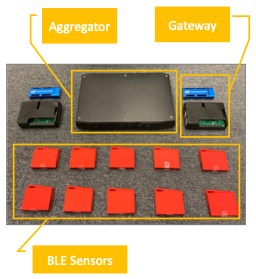Context
The IoT testbed at the University of Adelaide investigates the concept and engineering challenges of decentralised ad-hoc IoT infrastructures that can be adapted and deployed in different situations and environments to support a diverse set of studies. These infrastructures resemble the ad-hoc infrastructures rapidly assembled in the field to operate IoT sensors and autonomous systems for use cases such as emergency response in a disaster struck region.
Testbed Design
Hardware

The IoT testbed at the University of Adelaide is made up of multiple groups of devices called test kits. Each kit comprises multiple wireless sensors or autonomous systems connecting to multiple battery-powered computers acting as gateways. The gateways are coordinated by a stationary, resource-rich computer acting as a fog nodes or aggregators. The following figure presents an exemplary test kit.

Testkits are coordinated and supported by a set of servers acting as the data processing and storage services. The following figure provides an overview of the hardware making up the IoT testbed.

The number and types of devices within a test kit can be customised prior to a deployment. These deployments form a part of an exploratory or evaluative experiment. A test kit generates results after deployments. For instance, the results can be a dataset about real-world observations or a dataset of performance and resource consumption of the data processing or machine learning component deployed upon the test kit itself.
Software
The software of the testbed covers three aspects:
- Operations within each IoT test kit
- Management of a device inventory across distributed test kits
- Tasking of distributed test kits for experimentation
Case Studies
Some case studies and proof-of-concept implementations of IoT-based solutions that leverage the testbed
Datasets
Some datasets generated by the testbed